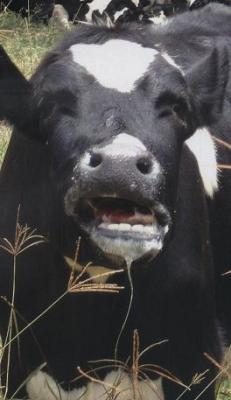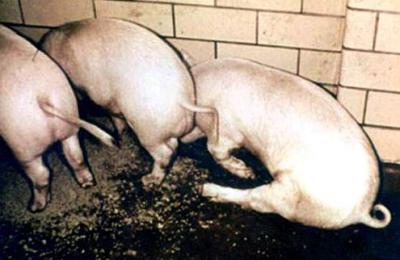Foot and Mouth Diseases (FMD)
Scientific name: Aphtae epizooticae
Local names
Luo: olawo, achany / Maragoli: azuya / Gikuyu: muguruma / Gabbra: oyale / Kamba:muthingithu / Kipsigis:ngworek / Maasai: Olkuluk, loirobi, olguluk / Samburu: ikulup / Somali: dila, labeb, abeb, abeeb / Swahili: ugonjwa wa miguu na midomo / Turkana:lojaala, ebaibai, lokulup / Luidakho: man'gwali / Luvugusu: gamalenge / Nandi: maikutiet
Common names: afthosa, aphthos fever, fievre aphteuse (French) fiebre aftosa (Spanish)
Description Specific management disease
 |
| Early FMD symptoms |
|
© Dr. Hugh Cran, Nakuru, Kenya
|
Introduction
| WARNING: Notifiable disease! If you suspect an animal has foot and mouth disease, you must inform the authorities immediately |
Foot and mouth disease is a highly contagious viral infectious disease of cattle, sheep, goats and pigs. It can also affect wild animals, especially buffalo, which act as significant hosts, and in which the disease is generally much milder than in cattle. It is caused by seven serotypes of Foot and Mouth disease virus namely: A, O, C, SAT 1, SAT 2, SAT 3 and ASIA 1.
Mode of spread
The virus can be harboured for periods in the nose and throat of wild animals.
The importance of the disease in small stock such as sheep and goats is largely as carriers of the disease to cattle; but in Kenya it has been shown that goats are infrequent carriers and sheep not at all. The disease is enzootic in many parts of the world.
FMD is mainly transmitted through inhalation or ingestion of the virus from contaminated feeds and direct contact with infected animals. The incubation period is on average 3 to 8 days after the animals are infected with the virus. Infected animals will then discharge the virus to materials they are in contact with or directly to other animals, thereby infecting them. This can be through the saliva, rupture of vesicles and blisters on the tongue and feet, discharges from the nose, and through coughs.
Meat, milk and semen from infected animals can spread infection.
Humans can also transfer infection to other animals through movement of people and vehicles from infected premises to susceptible areas. People working with infected cattle can harbour the virus in their nasal mucosa for up to 28 hours. Ticks also spread infection.
Windborne spread can be important under certain conditions as can spread by flocks of birds.
The important thing to remember is that this is one of the most contagious diseases known, and to act accordingly by taking every possible measure to prevent the entry of infection.
Signs of foot and mouth disease
- Severe lameness, due to the presence of blisters and vesicles between the toes, which then rupture and become secondarily infected
- The animals develop a high fever, become weak and dejected, and there is a rapid loss of condition. Mortality in calves is high
- Cattle stop eating due to the pain arising from the lesions in the mouth
- There is a drastic drop in milk production
- The coat becomes rough and there are blisters and vesicles inside the mouth especially on the tongue. There is profuse salivation with long ropey strings of saliva, and a characteristic smacking of the lips
- Blisters also form above and between the claws, and some blisters appear on the teats.
- Abortion is common
- Most animals recover but there is a frequent chronic and sometimes permanent loss of condition.
- In some instances, heart failure may occur causing sudden death
- Any combination of salivation and lameness with blisters and vesicles in the mouth must always be regarded as being Foot and Mouth Disease until proved otherwise
- Sheep and goat suffer a much milder disease than cattle
- Also pigs can be affected by Foot and Mouth disease:
 |
| Typical posture of pigs with painful blisters on the feet |
|
© USDA
|
Diagnosis
- Clinical signs and history
- Samples of vesicular fluids and epithelium can be sent to the lab for confirmation and sero typing at FMD Research Institute at Embakasi in Nairobi, Kenya.
- Differentiate diagnosis with Foot rot for leg and foot lesions. The disease can also be confused with Bluetongue.
Diseases with similar symptoms
- Leg and feet lesion: see Foot rot
- Mouth lesions: see Rinderpest
- In sheep can be confused with Bluetongue
Prevention - Control - Treatment
Prevention and Control
- Report occurrence immediately so as to invoke quarantine after the disease is confirmed by the veterinary authorities. Such quarantines should be lifted only by the authorities, usually 6 weeks after the last recorded case.
- Disinfect premises and motor vehicle tyres with suitable disinfectant to prevent further infections.
- Vaccinate regularly. This should be done after determining the strain of the virus in order to give the correct sero type vaccine. Usually a multivalent vaccine is administered every 6 months as preventive measure. Outbreaks have occurred following vaccination and have been attributed to the production of carrier animals.
- Strict adherence to sanitary measures e.g. destruction of feed and beddings of infected animals.
Recommended treatment
There is no medical treatment for Foot and Mouth Disease. However, you can help the animals to recover:
- Shade them from the sun and give them plenty of water
- Give them soft feed such as green, soft, lush grass, which is better than hay as the blisters make it painful for the animals to eat. The addition of molasses is advised to give the animals energy.
- Use Magadi soda for foot baths and wound treatment.
- Give antibiotics by intramuscular injection to prevent secondary infection of the blisters.
| WARNING: Do not give antibiotics by mouth to adult cattle, camels, sheep and goats. It makes these animals sick by destroying essential bacteria in their rumens that are there as a vital part of the digestive process. |
Common traditional practices
Some of these are sensible and useful. Feeding of easily digested energy feeds are very beneficial as are disinfection of wounds with Magadi soda.
- Kipsigis: Mix 10 kg of maize flour in 10 litres of water. Add 2 kg of pounded finger millet. Allow to ferment for 3 days. Give an infected animal 4 litres of this brew to drink. Treatment for hooves: Spread 5 kg of ash or 5 kg of Magadi soda mixed with 5kg of ash in the morning and in the evening, at the entrance of the boma so the cattle must walk through it on the way to graze and when they return.
- Luo: Pound half a handful of fresh olulusia (Vernonia amygdalina) roots. Mix with 4 kg of finger millet flour and 5 litres of water. Sieve and drench adult cattle with 2 litres (1 litre for calves, goats and sheep) twice a day until recovery.
- Turkana: Mix 500 g of Magadi soda in 5 litres of water. Use the mixture to treat wounds in the mouth and externally on feet and teats. Repeat twice a day until recovery.
